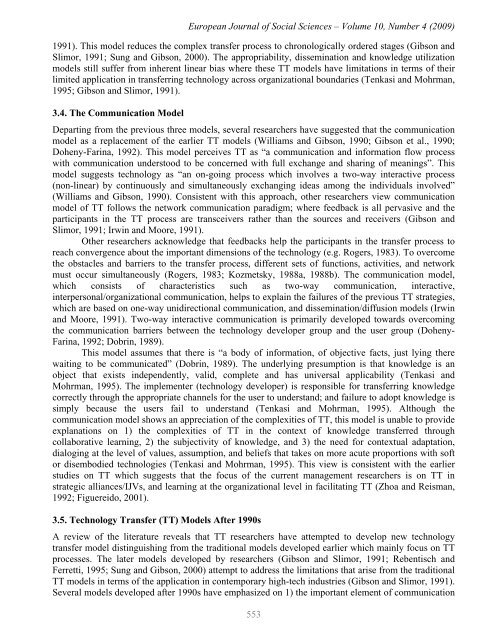A Review on the Technology Transfer Models ... - EuroJournals
A Review on the Technology Transfer Models ... - EuroJournals
A Review on the Technology Transfer Models ... - EuroJournals
Create successful ePaper yourself
Turn your PDF publications into a flip-book with our unique Google optimized e-Paper software.
European Journal of Social Sciences – Volume 10, Number 4 (2009)<br />
1991). This model reduces <strong>the</strong> complex transfer process to chr<strong>on</strong>ologically ordered stages (Gibs<strong>on</strong> and<br />
Slimor, 1991; Sung and Gibs<strong>on</strong>, 2000). The appropriability, disseminati<strong>on</strong> and knowledge utilizati<strong>on</strong><br />
models still suffer from inherent linear bias where <strong>the</strong>se TT models have limitati<strong>on</strong>s in terms of <strong>the</strong>ir<br />
limited applicati<strong>on</strong> in transferring technology across organizati<strong>on</strong>al boundaries (Tenkasi and Mohrman,<br />
1995; Gibs<strong>on</strong> and Slimor, 1991).<br />
3.4. The Communicati<strong>on</strong> Model<br />
Departing from <strong>the</strong> previous three models, several researchers have suggested that <strong>the</strong> communicati<strong>on</strong><br />
model as a replacement of <strong>the</strong> earlier TT models (Williams and Gibs<strong>on</strong>, 1990; Gibs<strong>on</strong> et al., 1990;<br />
Doheny-Farina, 1992). This model perceives TT as “a communicati<strong>on</strong> and informati<strong>on</strong> flow process<br />
with communicati<strong>on</strong> understood to be c<strong>on</strong>cerned with full exchange and sharing of meanings”. This<br />
model suggests technology as “an <strong>on</strong>-going process which involves a two-way interactive process<br />
(n<strong>on</strong>-linear) by c<strong>on</strong>tinuously and simultaneously exchanging ideas am<strong>on</strong>g <strong>the</strong> individuals involved”<br />
(Williams and Gibs<strong>on</strong>, 1990). C<strong>on</strong>sistent with this approach, o<strong>the</strong>r researchers view communicati<strong>on</strong><br />
model of TT follows <strong>the</strong> network communicati<strong>on</strong> paradigm; where feedback is all pervasive and <strong>the</strong><br />
participants in <strong>the</strong> TT process are transceivers ra<strong>the</strong>r than <strong>the</strong> sources and receivers (Gibs<strong>on</strong> and<br />
Slimor, 1991; Irwin and Moore, 1991).<br />
O<strong>the</strong>r researchers acknowledge that feedbacks help <strong>the</strong> participants in <strong>the</strong> transfer process to<br />
reach c<strong>on</strong>vergence about <strong>the</strong> important dimensi<strong>on</strong>s of <strong>the</strong> technology (e.g. Rogers, 1983). To overcome<br />
<strong>the</strong> obstacles and barriers to <strong>the</strong> transfer process, different sets of functi<strong>on</strong>s, activities, and network<br />
must occur simultaneously (Rogers, 1983; Kozmetsky, 1988a, 1988b). The communicati<strong>on</strong> model,<br />
which c<strong>on</strong>sists of characteristics such as two-way communicati<strong>on</strong>, interactive,<br />
interpers<strong>on</strong>al/organizati<strong>on</strong>al communicati<strong>on</strong>, helps to explain <strong>the</strong> failures of <strong>the</strong> previous TT strategies,<br />
which are based <strong>on</strong> <strong>on</strong>e-way unidirecti<strong>on</strong>al communicati<strong>on</strong>, and disseminati<strong>on</strong>/diffusi<strong>on</strong> models (Irwin<br />
and Moore, 1991). Two-way interactive communicati<strong>on</strong> is primarily developed towards overcoming<br />
<strong>the</strong> communicati<strong>on</strong> barriers between <strong>the</strong> technology developer group and <strong>the</strong> user group (Doheny-<br />
Farina, 1992; Dobrin, 1989).<br />
This model assumes that <strong>the</strong>re is “a body of informati<strong>on</strong>, of objective facts, just lying <strong>the</strong>re<br />
waiting to be communicated” (Dobrin, 1989). The underlying presumpti<strong>on</strong> is that knowledge is an<br />
object that exists independently, valid, complete and has universal applicability (Tenkasi and<br />
Mohrman, 1995). The implementer (technology developer) is resp<strong>on</strong>sible for transferring knowledge<br />
correctly through <strong>the</strong> appropriate channels for <strong>the</strong> user to understand; and failure to adopt knowledge is<br />
simply because <strong>the</strong> users fail to understand (Tenkasi and Mohrman, 1995). Although <strong>the</strong><br />
communicati<strong>on</strong> model shows an appreciati<strong>on</strong> of <strong>the</strong> complexities of TT, this model is unable to provide<br />
explanati<strong>on</strong>s <strong>on</strong> 1) <strong>the</strong> complexities of TT in <strong>the</strong> c<strong>on</strong>text of knowledge transferred through<br />
collaborative learning, 2) <strong>the</strong> subjectivity of knowledge, and 3) <strong>the</strong> need for c<strong>on</strong>textual adaptati<strong>on</strong>,<br />
dialoging at <strong>the</strong> level of values, assumpti<strong>on</strong>, and beliefs that takes <strong>on</strong> more acute proporti<strong>on</strong>s with soft<br />
or disembodied technologies (Tenkasi and Mohrman, 1995). This view is c<strong>on</strong>sistent with <strong>the</strong> earlier<br />
studies <strong>on</strong> TT which suggests that <strong>the</strong> focus of <strong>the</strong> current management researchers is <strong>on</strong> TT in<br />
strategic alliances/IJVs, and learning at <strong>the</strong> organizati<strong>on</strong>al level in facilitating TT (Zhoa and Reisman,<br />
1992; Figuereido, 2001).<br />
3.5. <strong>Technology</strong> <strong>Transfer</strong> (TT) <strong>Models</strong> After 1990s<br />
A review of <strong>the</strong> literature reveals that TT researchers have attempted to develop new technology<br />
transfer model distinguishing from <strong>the</strong> traditi<strong>on</strong>al models developed earlier which mainly focus <strong>on</strong> TT<br />
processes. The later models developed by researchers (Gibs<strong>on</strong> and Slimor, 1991; Rebentisch and<br />
Ferretti, 1995; Sung and Gibs<strong>on</strong>, 2000) attempt to address <strong>the</strong> limitati<strong>on</strong>s that arise from <strong>the</strong> traditi<strong>on</strong>al<br />
TT models in terms of <strong>the</strong> applicati<strong>on</strong> in c<strong>on</strong>temporary high-tech industries (Gibs<strong>on</strong> and Slimor, 1991).<br />
Several models developed after 1990s have emphasized <strong>on</strong> 1) <strong>the</strong> important element of communicati<strong>on</strong><br />
553

















